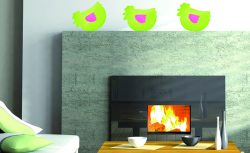
Common Definition: A manufactured fireplace appliance. These units are made of lightweight insulated metal and don’t require a foundation. Gas units with sealed glass doors are vented “directly” through an exterior wall. Since no chimney is required, they can be placed almost anywhere.
Unauthorized Definition: A cheap metal box that doesn’t look like a real fireplace. A fake fire, only slightly better than hanging a photo of a burning log on the wall.
Sound Like a Pro: “0-clearance” or “zero clearance” refers to the ability of these fireboxes to be placed near combustible framing. They’re tested and listed by the Underwriter’s Laboratory (UL) for safety in this configuration. The face of 0-clearance fireplaces still require a non combustible surround, as specified by the manufacturer. But they may not need a hearth.
In contrast, masonry fireplaces require large clearances from framing. Old school masonry fireplaces are governed by the building code and are not UL listed. In many areas masonry and other inefficient wood burning fireplaces are banned because of air pollution.
0-clearance fireplaces come in wood burning, gas log and sealed gas units. Wood burning units usually require a vertical “Class B” flue and wider clearances. Sealed, gas only units use a “direct vent” system and can be vented horizontally, directly to the exterior. Sealed gas units are common in areas like Denver Colorado, with air quality concerns, where wood burning is banned. Gas fireplaces, including unsealed gas logs, have electronic ignition and remote controls. Units of all three types, can come with air circulating fans for heating adjacent rooms.
Advantages of 0-clearance fireplaces include less expense and no need for foundation work. Easier venting is another benefit. As is increased energy efficiency with less air pollution. Disadvantages are mainly aesthetic. Many people feel these units appear fake. Quality manufacturers are getting better at approximating the look of masonry fireplaces.
Fun Trivia: Today with central heating and cooking appliances, fireplaces are largely considered symbolic. Yet, fire has always had a magical place in our hearts. Frank Lloyd Wright called the hearth the center of the home. The popular saying “home is where the hearth is”, reflects this attitude which stretches to ancient times. The Roman word for hearth is focus. Attesting to the timeless power of fire in our lives.
Archeologists don’t know exactly when hominids discovered fire. Evidence of the earliest campfires appear nearly one million years ago and are attributed to our ancestors Homo erectus. From the beginning, Homo sapiens (that’s us) were dependent on fire for safety, warmth and cooking. Early hunter-gatherer huts often had center fire rings. With a sedentary lifestyles the fire-centric hut eventually grew out of favor, because it’s not an efficient use of space.
In the early 1700s young Ben Franklin experimented with better ways to heat buildings, beyond the standard masonry fireplace. He invented the first free-standing firebox or cast iron stove. Ironically, the cast iron stove brought fire back into the center of the room like the first fire rings. These new fangled furnaces radiated heat in all directions, thus becoming more efficient than a typical masonry fireplace, but also less safe. Franklin refused to patent the new design. However, he did establish the first fire insurance company and fire stations.
Heat & Glo founders Ron and Dan Shimek revolutionized the fireplace industry once again with their patented direct vent technology in 1987. Allowing a gas fireplace to be vented horizontally instead of vertically. The first remote control fireplaces showed up around 1990. Today’s gas only, direct vented, remote control fireplace is quite safe in comparison to Franklin’s early prototype. Yet, many feel this appliance neuters the fire. Some designers even suggest a television playing a fire DVD is comparable and more energy-efficient.
Fireplace image by Dmitry Koksharov – Fotolia
« Back to Glossary Index